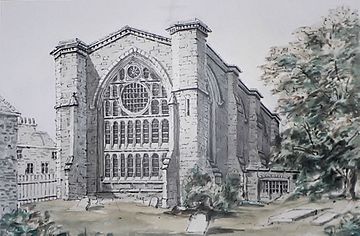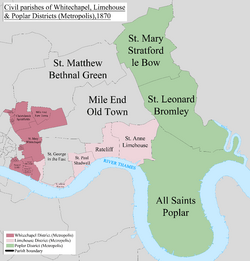Royal Foundation of St Katharine facts for kids
St Katharine's by the Tower (full name Royal Hospital and Collegiate Church of St. Katharine by the Tower) was a medieval church and hospital next to the Tower of London. The establishment was founded in 1147 and the buildings demolished in 1825 to build St Katharine Docks, which takes its name from it. It was re-established elsewhere in London and 123 years later returned once more to the East End. The church was a Royal Peculiar and the precinct around it was an extra-parochial area, eventually becoming a civil parish, which was dissolved in 1895. The Royal Peculiar survives to the present day as the Royal Foundation of St Katharine.
Contents
History
Medieval period
It was founded by Queen Matilda, wife of King Stephen, in 1147 in memory of two of her children, Baldwin and Matilda, who had died in infancy and been buried in the Priory Church of Holy Trinity at Aldgate. Its endowment was increased by two queens consort, Eleanor of Castile (who gave a gift of manors) and Philippa of Hainault. It was made up of three brothers, three sisters (with full and equal rights), a bedeswoman and six "poor clerks", all under a Master. It was a religious community and medieval hospital for poor infirm people next to the Tower of London. In 1273, after a dispute over its control, Queen Eleanor granted a new Charter, reserving the Foundation’s patronage to the Queens of England. For 678 years, the Foundation carried on its work in the East End of London despite periodic difficulties and renewal. In the 15th century its musical reputation rivalled that of St Paul's Cathedral and in 1442 it was granted a Charter of Privileges, which made it and its 23-acre (93,000 m2) precinct a Liberty with its own prison, officers and court, all outside the City of London's ecclesiastical and civil jurisdiction.
Early modern period
Its liberty status and the fact it was personally owned and protected by the Queen Mother, meant that it was not dissolved but re-established in a Protestant form. There were by now 1,000 houses (including a brewery) in its precinct, inhabited by foreigners and vagabonds, crammed along narrow lanes (with names like Dark Entry, Cat’s Hole, Shovel Alley, Rookery and Pillory Lane) and many in poor repair--John Stow's 1598 "Survey of London" called them "small tenements and homely cottages, having as inhabitants, English and strangers [i.e. foreigners], more in number than some city in England". Since the City's guilds' restrictions did not apply here, foreign craftsmen were attracted to the Liberty, as were many seamen and rivermen. It continued to exist through the religious changes of the time: reversion to Catholicism under Mary, return to Anglicanism under Elizabeth I and the Puritan Revolution.
The status of St Katharine's appears to be ambiguous with the court leet behaving more like a select vestry. The area was successfully incorporated into the weekly Bills of mortality returns, which was not typical for extra-parochial places in London.
Despite the high population density, however, in the Great Plague the Liberty's mortality rate was half of the rate in areas to the north and east of the City of London. Its continuing establishment of lay brothers and sisters, however, drew hostile attention from extreme Protestants—for example, it was only saved from being burned down by the mob in the 1780 Gordon Riots by a small group of pro-government inhabitants.
19th century and after
Georgian London, by then one of the world's largest cities, had seen several docks built to handle its huge shipping industry. There was commercial pressure for another dock, further upriver near the Pool of London, close to the heart of the City, and St Katharine's was chosen as the location in 1825. Some opposed the demolition of such an ancient establishment but in large part (in the words of Sir James Broodbank in his History of the Port of London) the dock construction was praised for demolishing "some of the most insanitary and unsalutary dwellings in London". The old buildings of St Katharine's Liberty were demolished and its inhabitants scattered, to create St Katharine Docks.
The area of St Katharine's by the Tower was grouped into the Whitechapel District in 1855 and became a civil parish in 1866 when its extra-parochial status ended, following the Poor Law Amendment Act 1866. The parish became part of the County of London in 1889. In 1895 it was abolished as a parish and combined with St Botolph without Aldgate.
The institution, now called the Royal Foundation of St Katharine, moved to Regent's Park, where it took the form of almshouses, and continued for 125 years. St Katharine's Church was built there in 1826-8, with Ambrose Poynter as its architect.
In 1948, St Katharine’s returned to East London to its present location in Limehouse, a mile from its original site, and became a retreat house with Father John Groser as Master and Members of the Community of the Resurrection from Mirfield providing worship and service. The Foundation remained under the care of this Community for some 45 years until 1993. In 2004, St Katharine’s modernised and expanded its facilities to include a retreat and conference centre, so making available its hospitality more widely within the Church of England and to other churches, charities, voluntary and public sector bodies and to associated individuals.
The former chapel of St Katharine at Regent's Park is now the Danish Church.
Masters of the College
Masters have been:
- Gilbert (1257)
- Walter de Runachmore (1263)
- Thomas de Chalke (1266)
- Stephen de Fulborne (1269)
- Thomas de Lechlake (1273)
- Symon de Stanbridge (1288)
- Walter de Reading (1295)
- John de Sandale (1315)
- Richard de Lutishall (1316)
- Robert de Bast (or Basse) (1327)
- William de Culshoe (1336)
- William de Erldesby (1340)
- Walter Watewany (1347)
- William de Hogate (1348)
- Dr. Paulet (1349)
- Paul de Monte-Florio (1351)
- John de Hermesthorp (1368)
- William de Kildesbey (or Killesby) (1377)
- Richard Prentys (1402)
- William Wrixham (1412)
- John Francke (1438)
- Thomas de Beckington (1444)
- John Delabere (1446)
- William Cleve (1449)
- Henry Trevilian (1461)
- Lionel Woodville (1475)
- William Wernham (1484)
- Richard Payne (1499)
- John Preston (1508)
- George de Athequa (1527)
- Gilbert Latham (1536)
- Thomas Seymour, 1st Baron Seymour of Sudeley (1547)
- Sir Francis Fleming (1549)
- Francis Mallet (1554)
- Thomas Wylson (1561)
- David Lewis (1581)
- Ralph Rokeby (1587)
- Julius Caesar (1596)
- Sir Robert Acton (1636)
- Dr. Coxe (1653)
- Henry Montague (1659)
- George Montague (1661)
- William Brouncker, 2nd Viscount Brouncker (1681)
- Sir James Butler (1684)
- Louis de Duras, 2nd Earl of Feversham (1698)
- Sir Henry Newton (1709)
- William Farrer (1715)
- George Berkeley (1738)
- Edmund Waller Jr. (1747)
- Stephen Digby (1786)
- Maj. William Price (1800)
- Col. Edward Disbrowe (1816)
- Maj-Gen. Sir Herbert Taylor (1818)
- William Ashley (1839)
- Rev. J.H.S. St. John Blunt (1879)
- Rev. Arthur L.B. Peile (1889)
- Rev. Severne Majendie (1914)
- Rev. St. John B. Groser (1948)
- Rev. Henry Cooper (1963)
- Rev. Augustine Hoey (1968)
- Rev. Jack Guinness (1972)
- Rev. George Sidebotham (1975)
- Rev. Christopher Lowe (1982)
- Rev. Malcolm Johnson (1993)
- Rev. Prebendary Ronald Swan (1997)
- Rev. Prebendary David Paton (2006)
- Rev. Mark Aitken (2013)
- The Venerable Roger Preece (2019)
Burials
- John Holland, 2nd Duke of Exeter
- VADM William Rainsborough, MP and English ambassador to Morocco
- Anne Stafford, Countess of March, (d. 20 September 1432)
- Thomas Walsingham died in 1457 and he and his wife, Margaret, were buried in the church of St Katherine’s by the Tower.
Population
The population of St Katharine's by the Tower at the decennial census was:
| Year | 1801 | 1811 | 1821 | 1831 | 1841 | 1851 | 1871 | 1881 | 1891 |
|---|---|---|---|---|---|---|---|---|---|
| Population | 2,652 | 2,706 | 2,624 | 72 | 96 | 517 | 241 | 104 | 182 |
Images for kids





